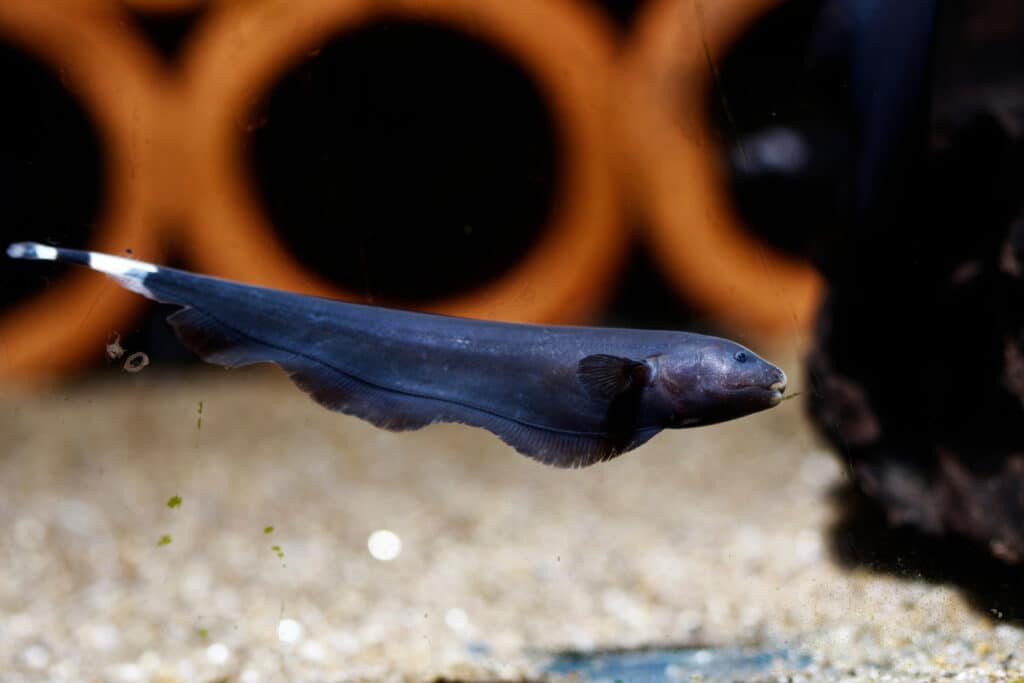Knifefish
Produce weak electric fields
Advertisement
Knifefish Scientific Classification
Read our Complete Guide to Classification of Animals.
Knifefish Conservation Status
Knifefish Facts
- Prey
- Insects, crustaceans, fish
- Main Prey
- Fish
- Name Of Young
- Fry
- Group Behavior
- Solitary
- Fun Fact
- Produce weak electric fields
- Biggest Threat
- Pollution and climate change
- Most Distinctive Feature
- Long, slender bodies and tapered tails
- Other Name(s)
- South American knifefish, Neotropical knifefish
- Average Spawn Size
- 1200
- Habitat
- Freshwater rivers and streams
- Predators
- Catfish, gar, birds, mammals
- Diet
- Carnivore
- Lifestyle
- Nocturnal
- Favorite Food
- Fish
- Number Of Species
- 250
- Location
- South America and Latin America
- Nesting Location
- Riverbeds
Knifefish Physical Characteristics
- Color
- Brown
- Grey
- Yellow
- Red
- Blue
- Black
- White
- Skin Type
- Smooth
- Lifespan
- 15 years
- Length
- 4 inches to 8 feet
- Age of Sexual Maturity
- Varies
- Venomous
- No
- Aggression
- Medium
View all of the Knifefish images!
Summary
Capable of producing electric fields, knifefishes belong to the order Gymnotiformes. The order currently contains 5 families and over 250 distinct species, including several species of electric eels. They live in freshwater streams and rivers throughout Central America and South America. Although they lack pelvic and dorsal fins, they can deftly maneuver in the water thanks to their elongated and pliable anal fins.
5 Knifefish Facts
- The first knifefish evolved approximately 120 million years ago during the Cretaceous period.
- Most can produce weak electric fields to navigate, detect prey, and communicate with one another.
- Some knifefishes, such as the electric eels in the genus Electrophorus, discharge electricity to stun their prey.
- Their fin rays can curve nearly twice as much as the rays of any other ray-finned fish, allowing them to navigate precisely without the need for pelvic or dorsal fins.
- Females prefer males that can produce lower-frequency electric signals despite the fact that these signals are more easily detected by predators because they indicate the males are proficient at evading detection.
Knifefish Classification and Scientific Name
All known species belong to the teleost bony fish order Gymnotiformes. The order’s name likely derives from the Greek word gymnos, meaning “to train naked,” and the Latin word iformes, meaning “the form of.” Taken together, the order’s name refers to the streamlined appearance of knifefishes and the fact that they lack pelvic and dorsal fins. Due to their geographic distribution, knifefishes also go by the name Neotropical knifefish or South American knifefish. Scientists recognize 5 families, 34 genera, and over 250 distinct species within this order. Their distant relatives include certain catfishes in the order Siluriformes and piranha and tetras in the order Characiformes.
The five families that make up the order Gymnotiformes include:
- Gymnotidae – banded knifefishes and electric eels
- Rhamphicthyidae – sand knifefishes
- Hypopomidae – bluntnose knifefishes
- Sternopygidae – glass and rat-tail knifefishes
- Apteronotidae – ghost knifefishes
Knifefish Appearance

Knifefish swim by rippling their anal fins while keeping their bodies rigid.
©Pavaphon Supanantananont/Shutterstock.com
Most have long, narrow bodies and tapering tails, hence “knifefishes.” Meanwhile, electric eels possess cylindrical bodies that only taper near the end. Unlike other bony fish, they lack pelvic and dorsal fins and have an extremely long anal fin that runs almost the full length of the body. This form lends them an eel-like appearance, although they are not closely related to true eels. Most lack teeth in the oral jaws, although some have brush-like teeth called villiform in the upper and lower jaws. Snouts also vary depending on the species. For example, sand knifefishes and ghost knifefishes have long, tubular snouts, while glass knifefishes and bluntnose knifefishes have relatively short, flat snouts. They range greatly in size from around 4 inches to almost 8 feet long, with an average of around 2 feet.
They swim by rippling their anal fins while keeping their bodies rigid. Their anal fins contain around 150 individual fin rays and can curve nearly twice as far as other ray-finned fish. They have full control over how their fins bend, allowing them to precisely adjust their direction of motion. They move by generating waves based on the patterns formed by their fins. Depending on the pattern, they can move forward or backward and adjust their angle upward, downward, and side-to-side.
Knifefish Distribution, Population, and Habitat
You can find them throughout the Neotropics, including Central and South America. They live in freshwater streams and rivers from southern Mexico to northern Argentina. Each species has its own preferred habitat when it comes to water depth and speed. For instance, bluntnose and banded knifefish, as well as electric eels, are common in small streams and floodplains with plenty of aquatic vegetation present. Banded knifefish and electric eels can even survive in murky water with low levels of oxygen. Meanwhile, ghost knifefishes and glass knifefishes are more present in large, swift-flowing rivers like the Amazon and its major tributaries. Ghost knifefishes frequent depths of around 16 feet, while you can find glass knifefishes at depths of up to 66 feet.
Knifefish Predators and Prey
In the wild, knifefish must contend with numerous predators. Smaller species are preyed upon by fish, including catfish, gars, and other knifefish. Larger species have fewer aquatic predators but must still contend with larger mammals and birds. To avoid predators, they tend to hide in deep cover during the day and also rely on their electric organs to create fields to help them detect the presence of predators.
They are nocturnal predators that prey on a wide variety of marine creatures. Common prey includes insects, worms, crustaceans, and small fish. Larger ones will also prey on amphibians, birds, and small mammals. They sense prey by detecting disturbances in the electrical fields around them. While most do not use electricity as a weapon, electric eels can create enough voltage to stun their prey.
Knifefish Reproduction and Lifespan
Each species has its own unique reproductive behaviors. Given their remote nature, scientists know little about the breeding habits of most species. Knifefish are notoriously difficult to breed in captivity because they require large amounts of space and specific conditions. Most breed during the rainy season and tend to locate their eggs in areas with plenty of cover such as near plants or driftwood. They also tend to breed at night, which makes observation of mating rituals difficult. However, researchers have been able to discern the habits of some species. For example, males and electric eels will build a nest to protect their eggs and young, known as fry. An electric eel female can lay up to 1,200 eggs, which the male then fertilizes with his sperm. Despite their seemingly great paternal instincts, knifefishes frequently eat their own eggs and young. If they live to reach adulthood, they can live up to 15 years in the wild and nearly 20 years in captivity.
Research indicates that females tend to prefer males that produce low-frequency signals. At the same time, low-frequency signals are more easily detected by predators. This odd form of sexual selection indicates that females prefer males who excel at avoiding predators. Males that can live to reach sexual maturity while also exhibiting low-frequency signals indicate that they are physically fit and, therefore, suitable mates. Their fitness also implies that they are able to effectively gather food and resources, thus indicating high reproductive capacity.
Knifefish in Food and Cooking
Generally speaking, they are not often eaten by humans. While some species are used as baitfish, they are otherwise of little commercial importance.
Knifefish Population
Most are little studied and not well-known. Many species live deep within the Amazon Basin and other Neotropical river systems, which makes them difficult to find and evaluate. Within their native range, they are fairly common and abundant and are not overly threatened by commercial fishing. A few species are popular in the pet trade, including black ghost knifefish (Apteronotus albifrons), glass knifefish (Eigenmannia virescens), and banded knifefish (Gymnotus carapo). However, their popularity as pets does not appear to have significantly impacted wild populations. Today, the greatest threats to them come from predators, pollution, and climate change. However, more research is required to determine if these factors are affecting knifefish populations.
Related Animals
View all 77 animals that start with KKnifefish FAQs (Frequently Asked Questions)
Are knifefish carnivores, herbivores, or omnivores?
Knifefishes are nocturnal carnivores that prey on a wide variety of creatures including crustaceans, insects, and small fish.
Where are knifefish found?
You can find knifefish throughout the Neotropics in small rivers and streams from southern Mexico to northern Argentina.
Are knifefish electric?
Knifefish generate electricity using specialized organs derived from their muscle cells, or in the case of ghost knifefishes from their spinal nerve cells. They use these electric fields to navigate, communicate, detect prey, and – in the case of electric eels – stun their prey.
How big do knifefish get?
The largest electric eels, Electrophorus voltai, can grow up to 8 feet long.
Thank you for reading! Have some feedback for us? Contact the AZ Animals editorial team.
Sources
- , Available here: https://www.sciencedirect.com/topics/agricultural-and-biological-sciences/gymnotiformes
- , Available here: https://www.newscientist.com/article/2268008-knifefish-use-electric-fields-to-develop-a-complex-social-hierarchy/
- , Available here: https://www.sciencedirect.com/topics/immunology-and-microbiology/gymnotiformes
- , Available here: https://www.ncbi.nlm.nih.gov/pmc/articles/PMC3722192/
















